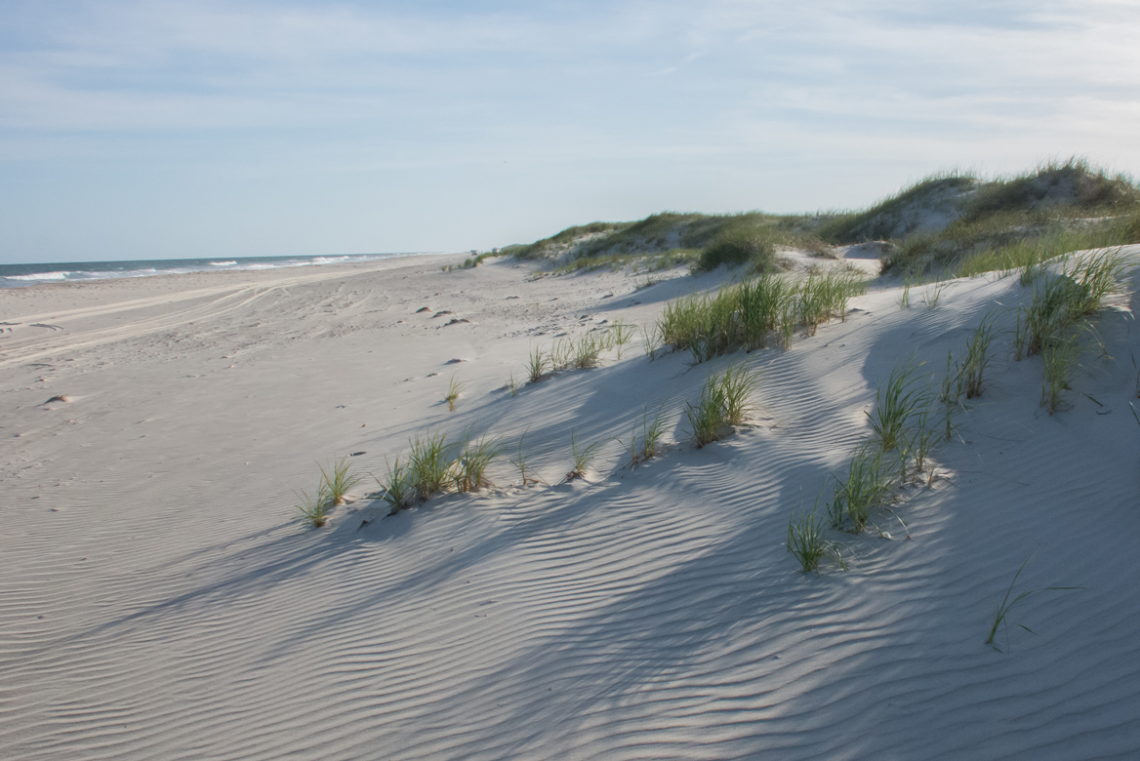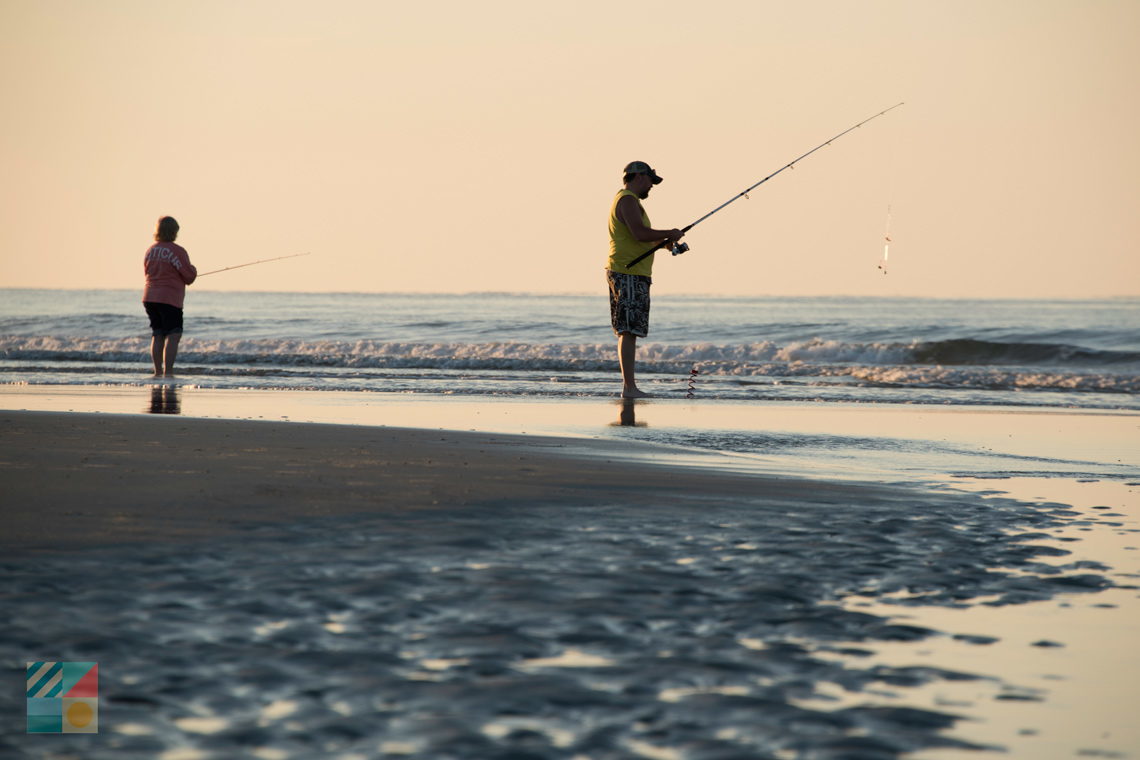Only a handful of Outer Banks visitors will make the long and arduous trek to Portsmouth Island, but those who do tend to return year after year, and with good reason. This small southern Outer Banks barrier island, located just south of Ocracoke Island on the other side of Ocracoke Inlet, is a rustic vacationer's paradise with unlimited camping options, incredible fishing, and some of the best shelling on the East Coast.

Portsmouth Island is a 13 mile-long island that's only accessible by a small boat or privately run ferry. There are no vacation homes, no stores, no businesses, and just a small handful of National Park Service (NPS) regulated and managed cottages that are clustered on the southern end of the island, and regular vacationers wouldn't have it any other way.
Because of its' hard-to-get-to location, and lack of modern amenities, Portsmouth Island remains one of the last wild frontiers of the Outer Banks, attracting vacationers who love roughing it, love being out in the wild, and simply want a 13-miles stretch of shoreline to call their own personal playground.
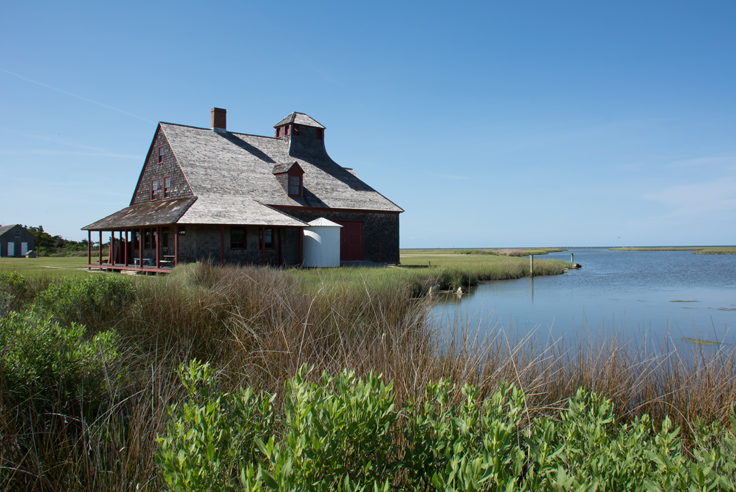
For a completely different beach adventure that is literally miles off the map, consider spending a day, a weekend, or even a week at pristine Portsmouth Island, and enjoy one of the last stretches of undeveloped North Carolina coastline in all its natural and wild splendor.
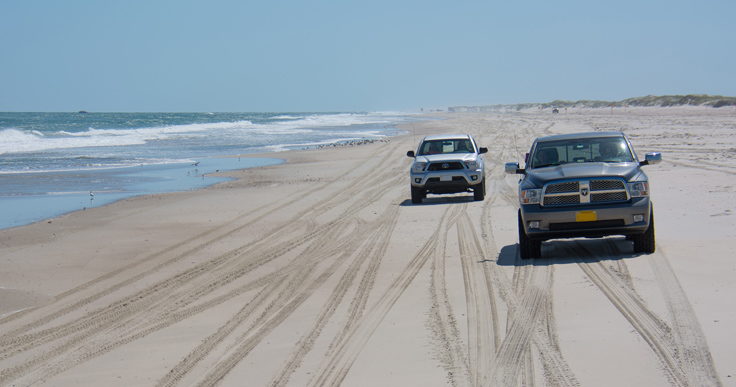
History of Portsmouth Island
Portsmouth Island wasn't always the rustic and abandoned retreat it is today, as evident by the small village consisting of a dozen remaining homes, churches, general store, and post office which is maintained in exceptional condition by the National Park Service.
In fact, Portsmouth was one of the first true bustling ports following European colonization. Already populated with a mixture of settlers, sailors and businessmen, the town was officially established in 1752, and by 1770, was the largest European settlement on the Outer Banks. This was in part due to its proximity to Ocracoke Island, one of the major North Carolina shipping ports, as well as its support facilities, which were built and maintained to provide easier trade and shipping through the narrow inlets along the coast.
The shipping industry along North Carolina thrived in the late 1700s and 1800s, and so did Portsmouth Island. It's estimated that by 1852, more than 66% of North Carolina's imported or shipped good passed through Ocracoke Inlet, by way of Portsmouth Island. The island, which boasted nearly 700 residents by 1860, was clearly thriving and was well on its way to being one of the most populated areas of the Outer Banks.

Portsmouth Island took its first hit during the Civil War. As Union soldiers patrolled the North Carolina coast, attacking its most populous ports, they targeted Portsmouth Village, and a number of residents fled the island before they could be overcome by the onslaught of troops. In addition to this, a new inlet had just formed south of Hatteras Village due to an 1846 storm, and the wide Ocracoke Inlet that attracted so many shipping vessels was slowly starting to close. The implementation of the national railroad, which helped carry goods all across the country, also hurt Portsmouth Island's status as a center of trade, as now virtually every port along the coastline was connected to the mainland.
After the Civil War, the inlet continued to dwindle with the original port becoming a shallow basin, and more and more residents grudgingly left the island in search of work and more fruitful opportunities.
The shipping industry soon abandoned Portsmouth Island for larger ports in the southern North Carolina and South Carolina beaches, and by 1956, only 17 hardy residents remained on the island with limited supplies. This number steadily declined as well, as with no stores or businesses, the residents of Portsmouth Island has to relay on goods that were brought in by private boat to the village. The last two residents, Marion Babb and Elma Dixon, two elderly ladies who had lived in the village for decades, finally and reluctantly left the island in 1971, and the "town" has been deserted ever since.
It only took a couple of years after being completely abandoned for the village, battered by consistent salty winds and no upkeep, to start to deteriorate, but by 1976 the Cape Lookout National Seashore (CLNS) was established, and new efforts were implemented by both the CLNS and concerned locals to bring Portsmouth Village back to life. Over the next four decades, old buildings that had been left to the elements were refurbished and renovated back to their original condition, and today visitors who stroll through the small sandy trails through Portsmouth Island would never guess that it has been 40 years since anyone called these pristine residences home.
The National Park Service continues to maintain the facilities, and a tour through Portsmouth Island's village is literally a step back in time, to the original working and thriving port of a small, working-class coastal community. Though a veritable ghost town, visitors attest it's one of the most remarkable villages on the Outer Banks, and return every year to marvel at the thoroughly well-kept remains, as well as the heritage and history of the Outer Banks' once-busiest and most prosperous settlements.

Getting to Portsmouth Island
As stated, getting to Portsmouth Island is part of the adventure, and most visitors to this secluded stretch of the southern Outer Banks will find reaching the shoreline a bit of a challenge.
The only way to reach Portsmouth Island is by boat, and perhaps the most convenient method is to commandeer your own small Carolina skiff or other motorized vessel across Ocracoke Inlet or Cedar Island to the two small docks that are located on both ends of the island. A handful of inshore charter businesses on Hatteras Island, like Got 'Em Charters based out of Teach's Lair Marina, even offer trips to the area upon request.
Visitors who want a more extended stay, and who may not own their own aquatic ride to commandeer to Portsmouth's shores, can also catch a ride aboard the Morris Marina Ferry. Based out of Atlantic, NC, (just 10 miles away from the Cedar Island ferry docks), the Morris Marina offers the only private vehicle ferry to Portsmouth Island.
It should be noted that there are a handful of other ferry services along Cedar Island and the Crystal Coast that can provide taxi services to visitors on foot, who simply want to explore the Cape Lookout area. However, Portsmouth Island is genuinely best explored with a 4WD vehicle, and Morris Marina features two small ferries, the Donza Lee and the Green Grass, that can accommodate a half dozen or so vehicles, and shuttle them to the Portsmouth Island ferry docks.
The first thing you'll need to visit Portsmouth Island this way is obviously a 4WD vehicle. There are no paved roads anywhere on the island, so 4WD is essential before even considering getting onboard a ferry. The second thing you'll need is a reservation. The ferry runs approximately 4-8 times a day, depending on the season, and with limited spots aboard the small boats, reservations for this island taxi can fill up fast. (Be sure and book both an arrival and departure reservation. If you miss your Portsmouth Island departure, the ferries can often make room on the next trip, again, depending on the season.)
The ferry ride to Portsmouth Island takes approximately 45 minutes or so, depending on the weather and the number of vehicles on board. Once en route, many newcomers marvel at the both the novelty of having a vehicle on board such a small vessel, and the incredible views of Cedar Island, the Pamlico Sound, and Portsmouth Island along the way.
The ferry deposits vehicles on the southern end of Portsmouth Island, 100 yards or so away from the small modern community of vacation rental cottages managed by the NPS. Once onshore, 4WD vehicles, ATVs, and pedestrians are free to explore the beaches, relax, and enjoy the completely unspoiled shoreline.
Rates vary depending on the type of vehicle, as well as any accompanying equipment, such as a campers or pull-behind trailers. For rate and reservation information provided by the Morris Marina, visit this website.
Attractions of Portsmouth Island
One of the better-known attractions of Portsmouth Island is, of course, the village itself. Completely deserted except for a satellite NPS office set up in one of the larger structures, visitors can simply wander through the center of town and take in the historic and perfectly preserved village. Several building are open for the random travelers who pass through, including the general store which has glass cases and shelves stocked with 1930s and 1940s goods, and the United Methodist Church, which even features a guest book for the intrepid visitor to sign. An eerie but enthralling expedition, a self-guided tour through Portsmouth Island's village is almost a pre-requisite adventure for any visitor to this island's shores. Public restrooms are also located on the northern outskirts of town, along the path that leads to the fantastic beaches.
Speaking of beaches, Portsmouth Island's other claim to fame is literally 13 miles of completely unspoiled shoreline which is open to the public to enjoy.
One of the biggest attractions on the shoreline is fishing, and vacationing anglers can expect to reel in virtually every type of saltwater species that calls the Eastern Seaboard home, from flounder to trout, mackerel to mullet. The biggest prizes are the red and puppy drum that make seasonal appearances in the spring and fall months as they blaze past the North Carolina coastline during their migration south or north. During the drum runs, Portsmouth Island anglers will literally be able to reel in fish after fish with little competition and plenty of elbow room.
Like most all areas of the Outer Banks, fishing on Portsmouth Island is seasonal with certain varieties in abundance for a month or two. For more info on what's biting, visit the Portsmouth Island Fishing's website. With any luck, your next Portsmouth Island trip may very well produce the next big catch of the month.
For avid beachcombers, Portsmouth Island is a paradise, with hundreds of not thousands of local North Carolina shells washing ashore, perfectly intact, on a daily basis. The reason for the influx of incredible shells is simple geography coupled with isolation. Portsmouth Island is basically a "southern facing" beach with a gradual shoreline, or a gently sloping ocean floor with relatively small waves that allow shells to glide to the beaches without friction or damaging ocean waves.
As a result, beachcombers can expect to find a variety of North Carolina treasures in addition to some spectacular species that are more commonly found on the beaches of South Carolina, Georgia, and even Florida. These include the prized state shell the Scotch Bonnet, spiny murexes, helmet conchs, Florida Fighting Conchs, lightning whelks, channeled whelks, knobbed whelks, and even olive shells and sand dollars. Any of these finds would be mantle-worthy showpieces, but what makes Portsmouth Island unique is that visitors can find any and all of these species in abundance, particularly in the early spring and late fall, when the island hasn't seen beachcombers for months, or has just survived another coastal storm, and the miles of beaches are open for picking.
Some visitors even report instances of simply lounging by the water as a near-perfect whelk, Scotch Bonnet or conch washed up right on front of them, making Portsmouth Island shelling one of the easiest beachcombing locales on the East Coast.
Hikers, beach drivers, and all-around explorers will also fall in love with the area, for its miles upon miles of off-the-beaten paths. ATVs or 4WD vehicles can opt to explore the rustic sand tracks carved out along the shoreline, or take to the soundside in makeshift paths that border the sound and maritime forests and run parallel to the dunes. Small brown mile marker signs are posted throughout the shoreline to give drivers and navigators their bearings, and it's a good thing too - with so much undeveloped shoreline it's easy to forget, geographically, where you're located in the grand scheme of things.
When it comes to nature and wild explorations, it's hard to beat Portsmouth Island. Visitors who hop out of the vehicle for a little on-foot and self-guided hike will be delighted to find miles of maritime forests, woods, soundfront beaches, and gorgeous stretches of oceanfront just waiting to be unearthed.
The area is home to a number of barrier island regulars, including white-tailed deer, foxes, box turtles, seasonal loggerhead turtles and turtle nesting areas, and hundreds of different kinds of both migratory and year-round shorebirds. In addition, and due to its isolation and respect of visitors, the area is a thriving home to a number of endangered or threatened species, such as the Piping Plover or the American Oyster Catcher. On the shoreline, vacationers can expect to see ghost crabs peeking out of their small, self-burrowed holes, and even dolphins that swim courageously close to shore to check out human visitors.
Wildlife lovers, fishermen, and dedicated beachcombers all adore Portsmouth Island, and while on the surface it may seem like their initial interests are wildly different, in the end it all comes down to the same attraction. Portsmouth Island, because of its undeveloped and undiscovered nature, allows wild hobbies of all kinds to simply flourish on its shores, and visitors of all varieties can simply relax and enjoy the rewards.
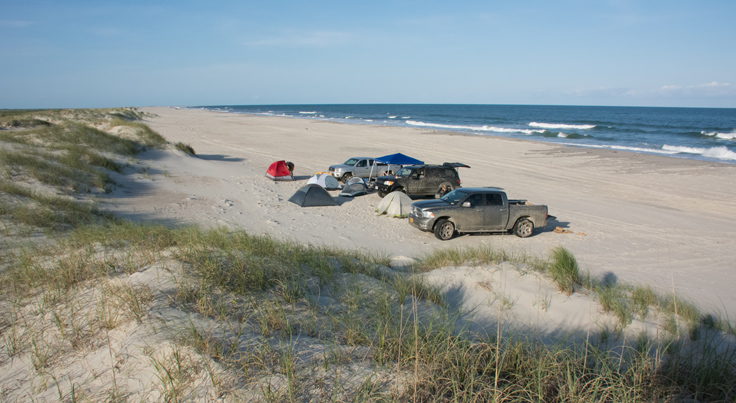
Lodging and Camping on Portsmouth Island
Portsmouth Island is unique on the Outer Banks in that rustic campers can literally choose any stretch of shoreline to stake a tent. Tent and RV campers are allowed throughout the island, including on the beaches, the dunes, the maritime forests, and even adjacent to the soundfront for perfect evening sunsets over the water. Basically, if you can find a place to park or pitch a tent stake, then you can set up a temporary home away from home.
Over the years, a few established but hidden "camping sites" have been claimed and developed throughout the shoreline, marked only by the brown milepost markers that consistently line the seashore. Tent campers, especially during the breezy fall and spring months when wind speed can reach a consistent 15-20 mph, are advised to stay away from the oceanfront, and explore the tucked-away patches of soundfront and maritime forest. Not only do these sections of the island provide a natural barrier against the wind, but campers here can enjoy the best of the island's wildlife right outside their tent door.

Of course, all campers are expected to follow the Cape Lookout National Seashore's guidelines, which can be found on the NPS website, and are advised to leave nothing behind and take nothing with them but pictures, fresh catches, and fantastic seashells.
To find that perfect spot that's away from the oceanfront and the wind, simply follow the "interior" trail that winds along the west side of the ocean-facing sand dunes, and look for slightly-used and navigated paths leading towards the soundfront. In these relatively undiscovered areas, rustic campers can find sites that border brackish or saltwater ponds, clusters of dense maritime forests, sprawling saltwater marshes, or even picturesque soundfront beaches. With ample room to explore, many campers find it's hard to narrow down one locale to spend their stay, but when you do find that perfect site, you're sure to return to your same makeshift "vacation destination" on Portsmouth Island for years to come.
It should be noted that amenities and facilities are extremely limited for rustic campers. The Morris Marina staff is happy to make runs to town for necessary goods, such as groceries, snacks or beverages, but otherwise, campers are on their own. There are public restrooms located at both ends of the inlet, at the NPS campground and on the edge of Portsmouth Village, and public showers are also located within the NPS's camping facilities on the southern end of Portsmouth Island.

Portsmouth Island visitors who don't necessarily want to rough it, but still want to enjoy the seclusion and the postcard-perfect beaches, can also stay at the National Park Service Campground, located at the southern end of Portsmouth Island next to the Morris Marina Ferry docks.
This campground features 20 "sites," or duplex or circular beach cottages that are open to visitors. There is no electricity on Portsmouth Island, however these cottages have generators which provide interior lighting, functioning stoves, hot showers, and even air conditioning in the hot summer months.
Each cabin or duplex unit generally sleeps 6, with bunk beds or even single beds depending on the layout, and is literally steps away from the beach right outside the door. Each unit also has kitchen cabinets, a table and chairs for impromptu dining, and ceiling fans to circulate those ocean breezes. Several units even have propane heaters for shoulder season guests. Reservations are required, and can be obtained by visiting the Long Point Cabin Camp's website.
Portsmouth Island ATV Tours
Some visitors may wish to forego the extensive stays and long travel involved with a weekend or week-long vacation on Portsmouth Island, and simply spend a morning or afternoon discovering this unique region of the Outer Banks. For those folks, the Portsmouth Island ATV Tours fit the bill, as it provides an efficient exploration of the island's most popular and attractive regions.
The Portsmouth Island ATV Tours, provided by the Ocracoke native Austin Boat Tour company, is the only standardized tour available to Portsmouth Island vacationers, thanks to a long-standing partnership with the National Park Service.
Tour participants must make reservations well in advance at the tour's website, as spots fill up fast, especially in the prime summer season months when Ocracoke's tourism population is at its highest.
On the morning or afternoon of your tour, be sure and show up at the docks at least 20 or 30 minutes before departure to sign in, get situated on the boat, and receive your "shell bag" to collect treasures scooped out of the Atlantic Ocean waters.

Each tour can accommodate just a handful of visitors, and the journey begins with a scoot across Ocracoke Inlet onboard the boat, which lands on the outskirts of Portsmouth Village. Here, ATVs which can accommodate 4 passengers are waiting to escort tour-goers through the village. In good conditions, tourists are encouraged to hop off and walk around the village, but on buggy days, the tour of the village is slightly abbreviated to ensure a minimal number of mosquito bites, and instead allocates that time to exploring the Portsmouth Island shoreline.
Here, visitors can ride along the beaches in their ATVs and enjoy a bit of "drive-by shelling" as they scoop up treasures that are freshly washed onshore. An experienced guide leads the pack, pointing out interesting sites and facts along the way, (as well as some fantastic shell finds that may be lost on the casual observer.)
The finale of the tour leads to a secluded beach where tour-goers can simply enjoy the water and the fresh air of a stretch of gorgeous Portsmouth Island shoreline as they wait for the boat that will lead them home.
Visitors are encouraged to bring along bottled water and snacks as there are limited facilities on the island, as well as sunscreen and bug spray. Group tours are also available, and the tours generally leave the Ocracoke Harbor twice a day, depending on both the season and weather conditions.
For an easy-going exploration of Portsmouth Island that doesn't require excessive travel or accommodation planning, the Portsmouth Island ATV Tours may be just the ticket to introduce newcomers to this relatively unheard of stretch of Outer Banks beach.
Tips and Trips for Visiting Portsmouth Island
- Bug spray is a requirement during any time of year, but is most required during the prime summer months of June, July and August. Inshore areas, such as Portsmouth village itself and parcels of maritime forest and marshes, are the most susceptible to mosquitos. That said, visitors who stick close to the ocean and the subsequent salty breezes need not worry as much, especially in the spring and fall months when the mosquito population is relatively dormant.
- Rustic campers are encouraged to bring along plenty of supplies. The staff at Morris Marina are happy to pick up essentials and deliver them back to on-island campers, however, coming to the island prepared is a key ingredients to fully enjoying a Portsmouth Island vacation.
- Be sure and mind the NPS rules and regulations, which include but are not limited to having pets leashed at all times, disposing of litter, and staying within the beach campfire guidelines. By heeding these rules, visitors can ensure the beaches will remain open for generations to come.
- Portsmouth Island has no internet and limited cell phone service, however many visitors are surprised to discover that they are able to place calls or go online even in the middle of nowhere. Be sure and bring vehicular-chargers however, as the only electric outlets on Portsmouth Island are found sparingly in the island's 20 NPS managed cabins. (Although, truth be told, many vacationers are more than happy to be cut off from the rest of the world.)
- Bring plenty of coolers for fish, and plenty of bags for shells. Many first-time vacationers are surprised at the number of exceptional catches both on and off the shore that they reel in, and sometimes find themselves throwing away food and supplies to make room for their newly discovered treasures. Allot a large space in the truck or the ATV to ensure that all of your finds are able to travel across Ocracoke inlet with you and find a permanent place back home.
Portsmouth Island can often be a literally off-the-map destination for most Outer Banks vacationers. Located just south of Ocracoke Island, and with no businesses, restaurants, or shops to speak of, it's understandable the visitors who are new to the Outer Banks regions have never heard of this delicate parcel of North Carolina coastline.
However, adventurous vacationers who love a wide-open landscape to pitch a tent, in addition to dedicated fishermen and shell seekers, will find Portsmouth Island a vacation dream come true. With miles of undeveloped shoreline to explore, and a bit of history thrown in within the confines of the fantastically-preserved Portsmouth Village, this is one beach vacation destination that is completely unique, wild, and completely beloved by its loyal sect of vacationers.
Like every other section and region of the Outer Banks, Portsmouth Island has its devout followers, and all it takes is a visit or two to determine if you're continually in a PI sort of mind.
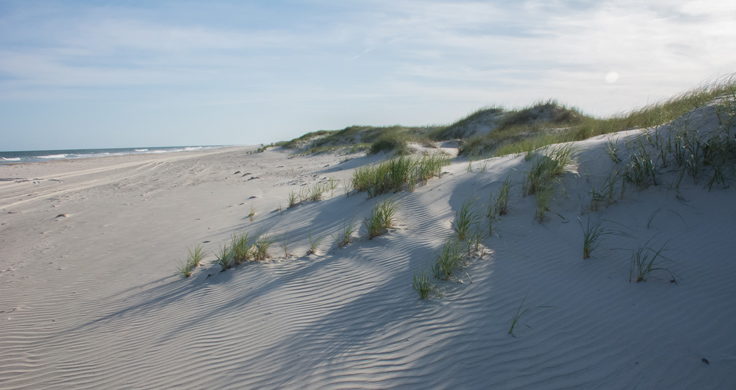
Frequently Asked Questions
Where is Portsmouth Island, NC?
Portsmouth Island is an isolated barrier island that is located within the Cape Lookout National Seashore. It is bordered to the north by Ocracoke Inlet and Ocracoke Island, and is bordered to the south by Cape Lookout and the South Core Banks.
How do you get to Portsmouth Island, NC?
Visitors can reach Portsmouth Island via a private vessel, or by a boat tour or passenger / vehicular ferry. Boat tours launch from neighboring Ocracoke Island, and a passenger / vehicle ferry that accesses Portsmouth Island is located in the town of Davis on the North Carolina mainland.
What’s the easiest way to get to Portsmouth Island?
The quickest way to reach Portsmouth Island is via Ocracoke Island, which is just 2-3 miles away from the northern tip of Portsmouth Island. Boat tours and ATV tours are regularly available in the summer months in Ocracoke village.
Do you need a 4WD vehicle to explore Portsmouth Island?
Because Portsmouth Island has no paved roads, a 4WD vehicle is recommended to explore the miles of undeveloped shoreline. Pedestrians can access Portsmouth Island, however, via area boat tours and passenger / vehicular ferries.
Are there tours of Portsmouth Island?
Tours of Portsmouth Island are available in Ocracoke village, and can include private boat tours, boat and ATV tours, or inshore charter fishing trips.
Are there wild horses on Portsmouth Island?
Although there are wild horses in the southern regions of the Cape Lookout National Seashore, (including the South Core Banks and the Shackleford Banks), surprisingly, there are no wild horses on Portsmouth Island.
Where is Portsmouth Island Village?
Portsmouth Island Village is located on the northern tip of Portsmouth Island, just across the inlet from Ocracoke Island.
How old is Portsmouth Island village?
The historic Portsmouth Village on Portsmouth Island was established in the 1750s and was one of the largest port communities along the North Carolina coastline by the mid-19th century. Eventually, as the harbor began to shallow and railroads were established at other large coastal ports, the population dwindled until the last two residents - Marion Babb and Elma Dixon – left the island in 1971.
Are the mosquitos bad on Portsmouth Island?
The mosquitos on Portsmouth Island are legendary. Warm weather visitors are advised to bring along plenty of bug spray and even mosquito netting, especially if they are exploring inland areas away from the beach, such as the historic Portsmouth Village.
Where can you camp on Portsmouth Island?
Camping is allowed throughout the Portsmouth Island shoreline for tents and / or 4WD trucks and RVs. (Camping is not allowed within the historic district of Portsmouth Village.) There are also rustic cabins available to rent on Portsmouth Island, which are available through the Cape Lookout National Seashore.
Does anyone live on Portsmouth Island?
Portsmouth Island was occupied for centuries, but is now a deserted seaside ghost town. The last residents to live on Portsmouth Island were two older women, who left the island in the 1970s.
Where are the ferries that go to Portsmouth Island?
A boat and ATV tour that accesses Portsmouth Island is located in Ocracoke village, while a passenger / vehicular ferry that heads to Portsmouth Island is found in the mainland town of Davis, NC, on Cedar Island.
How long is the ferry ride to Portsmouth Island?
From Davis, NC, the passenger / vehicular ferry to Portsmouth is approximately 45 minutes to one hour, depending on the weather conditions.
What is there to do on Portsmouth Island, NC?
Portsmouth Island is isolated and undeveloped, and is famous for its exceptional shelling and surf fishing. The island is also home to the historic Portsmouth Village, which is a now-deserted village that was established in 1752, and which was occupied until the early 1970s.
What are the special events on Portsmouth Island?
The historic Portsmouth Village on Portsmouth Island hosts a homecoming every year in April, where descendants and friends of Portsmouth Island gather together in the heart of the village.
Are there lifeguards on Portsmouth Island?
There are no lifeguards on Portsmouth Island.
What are the attractions on Portsmouth Island, NC?
Portsmouth Island’s primary attractions are the beaches, and the historic Portsmouth Village. Now deserted, the village still has a number of restored buildings and structures, including the Portsmouth United Methodist Church, a general store, and a National Park Service ranger station and visitor center.
Are there shops and restaurants on Portsmouth Island, NC?
There are no restaurants or shops on Portsmouth Island.
Is there drinking water and restrooms on Portsmouth Island?
Facilities are very limited on Portsmouth Island. Restrooms and / or drinking water can be found on the southern tip of the island near the National Park Service cabins, and on the northern end of the island near historic Portsmouth Village.
Where do you stay on Portsmouth Island, NC?
Visitors can camp anywhere on the Portsmouth Island beaches, except within the historic district where Portsmouth Village is located. There are also 20 rustic cabins that each sleep 6 people on the southern end of the island, which are managed by the Cape Lookout National Seashore.
Are pets allowed on the beach on Portsmouth Island, NC?
Pets are allowed throughout the Portsmouth Island beaches but must be on a leash.
Can I drive on the beach on Portsmouth Island, NC?
Driving is allowed throughout Portsmouth Island along the beaches and along marked interior roads that border the dunes. A 4WD vehicle – (truck or ATV) - is required.
Are there shells on Portsmouth Island, NC?
Portsmouth Island is known as one of the best shelling destinations in the state of North Carolina, due to its isolation and location well off the coast of the mainland.
Where do you find shells on Portsmouth Island?
Shells are scattered throughout the Portsmouth Island shoreline, and especially along beaches that border the island’s two adjacent inlets.
What kind of shells are on Portsmouth Island?
Portsmouth Island attracts a number of shells that are otherwise unusual on the North Carolina coastline. Favorite finds for shell collectors include Scotch Bonnets, Florida Fighting conchs, spiny murexes, whelks, and helmet conchs.
Are beach bonfires allowed in Portsmouth Island?
Beach bonfires are allowed below the high tide line on Portsmouth Island.
When is the best time to visit Portsmouth Island?
The best time to visit Portsmouth Island is in the fall and spring months, when the fishing and shelling is at its best, and the mosquito population is noticeably reduced. Generally, ferry service to Portsmouth Island is not available from early December until March.
What are the air temperatures each month in Portsmouth Island?
January - high: 54°, low: 40°F
February - high: 55°, low: 41°F
March - high: 60°, low: 46°F
April - high: 67°, low: 54°F
May - high: 74°, low: 62°F
June - high: 81°, low: 69°F
July - high: 85°, low: 75°F
August - high: 84°, low: 74°F
September - high: 81°, low: 69°F
October - high: 73°, low: 60°F
November - high: 64°, low: 52°F
December - high: 57°, low: 45°F
-
OBX Wedding Fest
January 16th, 2026 - January 18th, 2026 -
Hatteras Island Oyster Roast
February 7th, 2026 1:00 PM - 4:00 PM -
First Friday in Manteo
March 6th, 2026 6:00 PM - 8:00 PM
Henry's Restaurant offers down home, simple food done Outer Banks style. Henry's Restaurant has been serving the Outer Banks of North Carolina since the summer of 1989. They are pleased to be considered one of the most popular restaurants in Dare...
Canadian Hole may be an unfamiliar term to the typical, laid-back Hatteras Islander vacationer, but to windsurfers around the world, the phrase invokes thoughts of an exact, postcard-perfect locale on the Outer Banks, where windsurfing and water...
Discover the best homemade ice cream and authentic made-from-scratch New York Style pizza the Outer Banks has to offer at American Pie in Kill Devil Hills. An Outer Banks favorite for lunch, dinner or a delicious scoop of scrumptious ice cream after...
In the past few years, the Outer Banks has become a popular destination for large families and groups who are planning a beach wedding, a corporate retreat, or just a casual family reunion. This turn of recent events is due in no small part to the...
Since 1968, our family owned and operated company has offered families just like yours a wide selection of Outer Banks vacation rentals in beach communities and towns of Duck, Southern Shores, Kitty Hawk, Kill Devil Hills, Nags Head and South Nags...
The Roanoke Marshes lighthouse is often one of the most overlooked of the Outer Banks lighthouses, simply because of its small stature, limited visibility and remote location tucked away at the quiet east end of the Manteo waterfront.
Nor'Banks Sailing & Watersports beautiful location and top-of-the-line equipment, together with a friendly and professional staff make it one of the premier water sports centers on the Outer Banks. Nor'Banks' sound front location has a huge...
The Currituck Beach Lighthouse, located in the heart of Corolla, borders the historic Whalehead in Historic Corolla and still functions as a guide for passing mariners. At 162' feet tall, the lighthouse's First Order Fresnel light, (the largest size...
Founded in 1984 on the coast of the Outer Banks, NC, Farmer’s Daughter still remains a destination for people wanting great quality, outstanding selection of unique clothing, accessories, and gifts at affordable prices. Committed to offering...
The Ocracoke Island Lighthouse may not be the most imposing of the Outer Banks lighthouses, but as North Carolina's oldest lighthouse in operation, (and the second oldest in the United States), it is certainly one of the most beloved. At just 65...
Experience more adventure, fun, and style with Kitty Hawk Surf Company. As the trusted Outer Banks retailer for all top surf and lifestyle brands, including, Hurley, Billabong, RVCA, The North Face, Patagonia, Salt Life, Salty Crew, Volcom...
Once you have your coastal recreational fishing license in hand, it’s time to start thinking about gear. Anglers will find tons of options when it comes to equipment for casting into the surf, from custom designed rods and reels at local...
Since 2005, Outer Banks Blue has delivered exceptional vacations for OBX visitors. Our family-owned and locally managed rental company focuses on service and promises “a relaxing experience with a local touch.” Turn your dream vacation...
Located just South of Salvo proper, the Salvo Day Use Area provides a peaceful haven for families, beachgoers, and watersports lovers. This park offers the perfect backdrop for taking in the Outer Banks' rich history and natural beauty. Everyone may...
